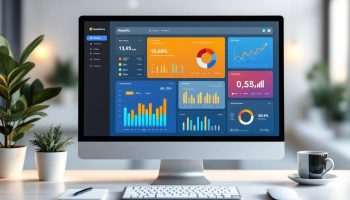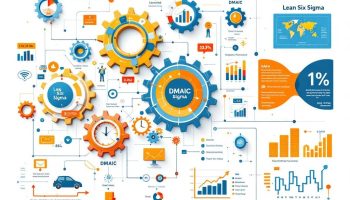
How Lean Value Stream Management Drives Business Excellence
Lean value stream management offers a systematic approach to eliminating waste and optimizing workflows across organizational processes. It combines lean principles with value stream mapping to identify bottlenecks, reduce lead times, and enhance operational efficiency.
Lean value stream management helps enterprises achieve sustainable competitive advantage by creating clear views of entire process chains from customer request to delivery. By analyzing value-added versus non-value-added activities, you can increase process efficiency ratios that typically show less than 10% of activities actually add customer value.
This approach allows companies to implement targeted improvements through structured Kaizen events, establish standardized work procedures, and develop continuous monitoring systems with aligned KPIs.
The outcome includes streamlined operations with shorter cycle times, reduced operational costs, and improved customer satisfaction—essential advantages in today’s competitive business landscape.
Lean Value Stream Management
Lean value stream management represents a game-changing approach for your business operations. This powerful methodology helps you identify waste, streamline workflows, and deliver maximum value to customers with minimal resources. When implemented correctly, lean value stream management can dramatically cut lead times, boost quality, and enhance customer satisfaction.
Foundation of Lean Value Stream Management
The foundation of this approach lies in systematic process analysis and continuous improvement. You’ll need to thoroughly assess your current operations before creating a more efficient future state. Through value stream mapping, you can visualize the flow of materials and information across your entire production process.
Ongoing Optimization
Organizations that excel at lean value stream management create sustainable systems for ongoing optimization, requiring commitment from leadership, employee engagement, and data-driven decision making. The results can transform your competitive position by reducing costs while improving service delivery.
Success in lean value stream management demands both strategic thinking and practical execution. By focusing on eliminating non-value-adding activities, you can create smoother, faster processes that respond better to customer needs and market changes.
1. Map Your Current Value Stream
The first step in effective lean value stream management is documenting your existing processes thoroughly. Begin by gathering your team to map out the current workflow from customer request to delivery. Lean value stream management requires a detailed understanding of how work actually flows through your organization.
Start by identifying all process steps, decision points, and handoffs between departments or individuals. Measure both cycle times (how long each activity takes) and wait times between activities. This data collection phase is crucial for understanding where delays occur in your system.
Pay particular attention to collecting information about:
- Defect rates at each process step
- Common bottlenecks that slow down work
- Information flow between teams
- Customer touchpoints and feedback mechanisms
- Resource allocation throughout the process
Create a visual representation of your current state using standard value stream mapping symbols. This visualization helps everyone collaborate effectively on the project by providing a shared understanding of the current workflow. Use different colors to highlight problem areas and opportunities for improvement.
2. Analyze Value-Add vs Non-Value-Add Activities in Your Lean Value Stream
Identifying which activities truly add value is critical to optimizing your lean value stream management process. Begin by categorizing each activity in your workflow as value-added (directly contributing to customer needs), business-necessary (required but not value-adding), or pure waste (activities that can be eliminated). This classification helps you focus improvement efforts where they’ll have the greatest impact.
Calculate process efficiency ratios by dividing value-added time by total lead time. This metric typically reveals that in most processes, less than 10% of activities truly add value from the customer’s perspective. When analyzing your lean value stream management system, look for the eight classic wastes:
- Defects requiring rework
- Overproduction beyond immediate needs
- Waiting time between process steps
- Non-utilized talent or skills
- Transportation of materials or information
- Inventory excess beyond requirements
- Motion waste from inefficient layouts
- Extra-processing beyond customer requirements
Review customer feedback carefully to determine what they truly value. This stakeholder satisfaction analysis will help you identify which activities deserve resources and which should be minimized or eliminated. Document all improvement opportunities in a centralized tracking system to ensure they’re addressed systematically during the implementation phase.
Expert Insight: To optimize your lean value stream, categorize activities into value-added, business-necessary, or waste. Focus on improving processes that align with customer feedback and prioritize eliminating pure waste. Use a centralized tracking system to document improvement opportunities for systematic implementation.
3. Design Future State Map for Lean Value Stream Management
Designing an effective future state map is a critical component of lean value stream management that helps you visualize the ideal workflow. When setting target metrics for improved flow, focus on reducing lead times and eliminating bottlenecks that impede your value stream. Your metrics should be specific, measurable, and aligned with customer expectations to drive meaningful improvement in your lean value stream management approach.
Implementing pull systems where appropriate helps prevent overproduction and reduces inventory waste. Rather than pushing work through the system based on forecasts, pull systems respond to actual customer demand, creating a more efficient lean value stream management process. Consider these key pull system elements:
- Kanban signals to trigger production
- Supermarkets for controlled inventory points
- FIFO lanes to manage work sequence
- Load leveling to balance production demands
Establishing standardized work procedures ensures consistency across your continuous improvement efforts. Document clear work instructions that capture the best practices identified during your lean value stream management analysis. These procedures should specify timing, sequence, and quality standards for each process step.
Creating balanced workload distribution prevents overburdening some resources while others remain idle. Use takt time calculations to match your pace of production with customer demand rate, which is fundamental to effective lean value stream management. This balancing act requires careful capacity planning and cross-training team members to handle variable workloads.
Defining new roles and responsibilities clarifies accountability in your transformed processes. Assign process owners who will maintain improvements and continue driving the lean value stream management initiative forward. These designated champions should have both the authority and resources to sustain positive changes over time.
Expert Insight: Design a future state map for lean value stream management by visualizing ideal workflows and focusing on reducing lead times and bottlenecks. Implement pull systems to align production with actual customer demand, and establish standardized work procedures to ensure consistency and accountability in your continuous improvement efforts.
4. Implement Changes Through Kaizen Events
Once you’ve designed your future state map, implementing lean value stream management requires focused action. Prioritize improvement initiatives based on their impact on flow and value creation. Begin with high-impact, low-effort changes to build momentum and demonstrate quick wins.
Form cross-functional implementation teams that include representatives from each area of the value stream. These diverse teams bring multiple perspectives and ensure all aspects of the lean value stream management process are considered. Assign clear roles and responsibilities to each team member to maintain accountability.
Execute rapid improvement workshops (kaizen events) to implement changes quickly. These structured 3-5 day events focus on specific improvement opportunities within your value stream:
- Define clear objectives and scope for each kaizen event
- Document current state conditions before making changes
- Implement and test solutions in real-time
- Standardize successful improvements immediately
- Document results and lessons learned
Monitor progress with visual management tools like action logs for tracking improvement activities. Visual boards displaying metrics and project status keep everyone informed and engaged. Regular stand-up meetings help maintain momentum and address emerging issues.
Address resistance to change by communicating benefits clearly and involving affected employees in the improvement process. Celebrate successes and recognize team contributions to build enthusiasm for ongoing continuous improvement efforts within your lean value stream management system.
Expert Insight: To successfully implement changes through Kaizen events, start by forming cross-functional teams and defining clear objectives. Focus on high-impact, low-effort changes to gain quick wins, and utilize visual management tools to track progress. Involve employees in the process to address resistance and celebrate improvements, fostering a culture of continuous enhancement.
5. Establish Continuous Monitoring System for Lean Value Stream Management
Implementing an effective monitoring system is critical to sustaining your lean value stream management efforts. Begin by defining key performance indicators (KPIs) that directly align with your value stream objectives. Select metrics that measure both process efficiency and customer value delivery, such as cycle time, first-pass yield, and on-time delivery performance.
Create a regular reporting cadence that keeps lean value stream management visible throughout your organization. Consider implementing:
- Daily huddles around visual management boards
- Weekly performance reviews with team leaders
- Monthly executive summaries highlighting trends and opportunities
Implement structured problem-solving protocols when metrics indicate performance issues. The root cause analysis process should be standardized across teams to ensure consistent problem resolution.
Schedule periodic value stream reviews—quarterly at minimum—to reassess the entire process flow and identify new improvement opportunities. These reviews should involve cross-functional stakeholders and focus on eliminating newly discovered waste.
Maintain comprehensive improvement documentation that captures both successful initiatives and lessons learned. This documentation becomes a valuable resource for continuous improvement efforts and helps prevent the recurrence of previously solved problems.
Expert Insight: Establish a continuous monitoring system by defining KPIs aligned with value stream objectives. Implement regular reporting and structured problem-solving protocols to address performance issues. Schedule quarterly value stream reviews with cross-functional stakeholders to identify improvement opportunities and maintain comprehensive documentation for ongoing learning and enhancement.
Lean value stream management is a systematic approach to identifying and eliminating waste while optimizing the flow of materials, information, and processes across an organization. This methodology involves mapping current workflows, analyzing value-added activities, designing improved future states, implementing changes through Kaizen events, and establishing continuous monitoring systems to sustain improvements.
Lean value stream management provides businesses with a competitive edge by significantly reducing operational costs and increasing customer satisfaction through faster delivery and higher quality. Organizations implementing this approach can identify and eliminate up to 90% of non-value-adding activities, leading to shorter lead times, improved resource utilization, and enhanced ability to respond to market changes quickly. The structured five-step process creates a framework for sustainable improvement that aligns operational excellence with strategic business objectives.
Optimizing Your Lean Journey: Key Takeaways
Effective lean value stream management requires a methodical approach that transforms how organizations deliver value to customers. By mapping current processes, analyzing value-added activities, designing future states, implementing changes through Kaizen events, and establishing monitoring systems, companies can eliminate waste and optimize their operations. The comprehensive approach addresses every aspect of the value stream, from initial customer request to final delivery, creating a foundation for continuous improvement that drives both operational excellence and customer satisfaction.
Action Plan for Lean Value Stream Implementation
- [ ] Document your current value stream by gathering cross-functional teams to map the entire workflow
- [ ] Measure cycle times and wait times at each process step to identify bottlenecks
- [ ] Categorize activities as value-added, business-necessary, or waste
- [ ] Calculate process efficiency ratios to determine improvement opportunities
- [ ] Design a future state map with specific, measurable targets for improved flow
- [ ] Implement pull systems that respond to actual customer demand
- [ ] Establish standardized work procedures for consistency
- [ ] Conduct Kaizen events focusing on high-impact, low-effort changes first
- [ ] Define KPIs that align with value stream objectives
- [ ] Schedule quarterly value stream reviews to identify new improvement opportunities
Frequently Asked Questions
- What is the difference between value-added and non-value-added activities? Value-added activities directly contribute to customer needs and what they’re willing to pay for, while non-value-added activities include business-necessary tasks (required but not valuable to customers) and pure waste (activities that can be eliminated entirely).
- How long does it typically take to see results from lean value stream improvements? While some benefits like reduced wait times can be seen immediately after implementation, more significant results typically emerge within 3-6 months as the improved processes stabilize and teams adapt to new workflows.
- What role do employees play in lean value stream management? Employees are crucial to successful implementation, as they provide insights into actual processes, identify improvement opportunities, and ultimately sustain the changes. Their involvement from the mapping stage through implementation is essential for lasting results.
- How often should value stream maps be updated? Value stream maps should be reviewed quarterly at minimum, with full updates recommended annually or whenever significant changes occur in products, processes, or market requirements.
- What metrics best indicate successful lean value stream management? Key metrics include lead time reduction, first-pass yield improvement, on-time delivery performance, inventory reduction, and overall process efficiency ratio (value-added time divided by total lead time).
- How does lean value stream management differ from traditional process improvement? Unlike traditional improvement that often focuses on isolated processes, lean value stream management examines the entire flow from customer request to delivery, optimizing the whole system rather than individual components.






